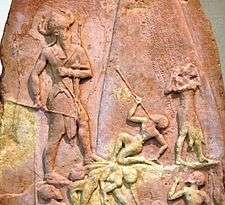Lullubi
The Lullubi or Lulubi were a group of Pre-Iranian tribes during the 3rd millennium BC, from a region known as Lulubum, now the Sharazor plain of the Zagros Mountains of modern Iraqi Kurdistan. Frayne (1990) identified their city Lulubuna or Luluban with the region's modern Kurdish town of Halabja.
Historical references
The early Sumerian legend "Lugalbanda and the Anzud Bird", set in the reign of Enmerkar of Uruk, alludes to the "mountains of Lulubi" as being where the character of Lugalbanda encounters the gigantic Anzud bird while searching for the rest of Enmerkar's army en route to siege Aratta.

Lullubum appears in historical times as one of the lands Sargon the Great subjugated within his Akkadian Empire, along with the neighboring province of Gutium, which was probably of the same origin as the Lullubi. Sargon's grandson Naram Sin defeated the Lullubi and their king Satuni, and had his famous victory stele made in commemoration. After the Akkadian Empire fell to the Gutians, the Lullubians rebelled against the Gutian king Erridupizir, according to the latter's inscriptions.
Following the Gutian period, the Neo-Sumerian (Ur-III) ruler Shulgi is said to have raided Lullubi at least 9 times; by the time of Amar-Sin, Lullubians formed a contingent in the military of Ur, suggesting that the region was then under Neo-Sumerian control.
Another famous rock relief depicting the Lullubian king Anubanini with the Assyrian-Babylonian goddess Ishtar, captives in tow, is now thought to date to the Ur-III period; however, a later Babylonian legendary retelling of the exploits of Sargon the Great mentions Anubanini as one of his opponents.
In the following (second) millennium BC, the term "Lullubi" or "Lullu" seems to have become a generic Babylonian/Assyrian term for "highlander", while the original region of Lullubi was also known as Zamua. However, the "land of Lullubi" makes a reappearance in the late 12th century BC, when both Nebuchadnezzar I of Babylon (in c. 1120 BC) and Tiglath-Pileser I of Assyria (in 1113 BC) claim to have subdued it. Neo-Assyrian kings of the following centuries also recorded campaigns and conquests in the area of Lullubum / Zamua. Most notably, Ashur-nasir-pal II had to suppress a revolt among the Lullubian / Zamuan chiefs in 881 BC, during which they constructed a wall in the Bazian pass (between modern Kirkuk and Sulaymaniyah) in a failed attempt to keep the Assyrians out. They were said to have had 19 walled cities in their land, as well as a large supply of horses, cattle, metals, textiles and wine, which were carried off by Ashur-nasir-pal. Local chiefs or governors of the Zamua region continued to be mentioned down to the end of Esarhaddon's reign (669 BC).
Thomas Bois, Ephraim Avigdor Speiser and Nikolai Yakovlevich Marr[1] opined that the Lullubi may have been the ancestors of the modern Kurds.[2]
See also
References
- ↑ F. HENNERBICHLER, The Origin of the Kurds Georgia-born linguist and historian Nikolaĭ Yakovlevich Marr (1864-1934), and Ephraim Avigdor Speiser (1902-1965),Galicia-born Orientalist, and long-time Chairman of the Department of Oriental Studies (1947-1965) at the University of Pennsylvania, USA. Both explained Kurds as descendants of the Guti (and Lulubi)
- ↑ Thomas Bois, The Kurds, 159 pp., 1966. (see p.10)
- Cambridge Ancient History
- Sar-e Pol-e Zahab
- Lullubi
